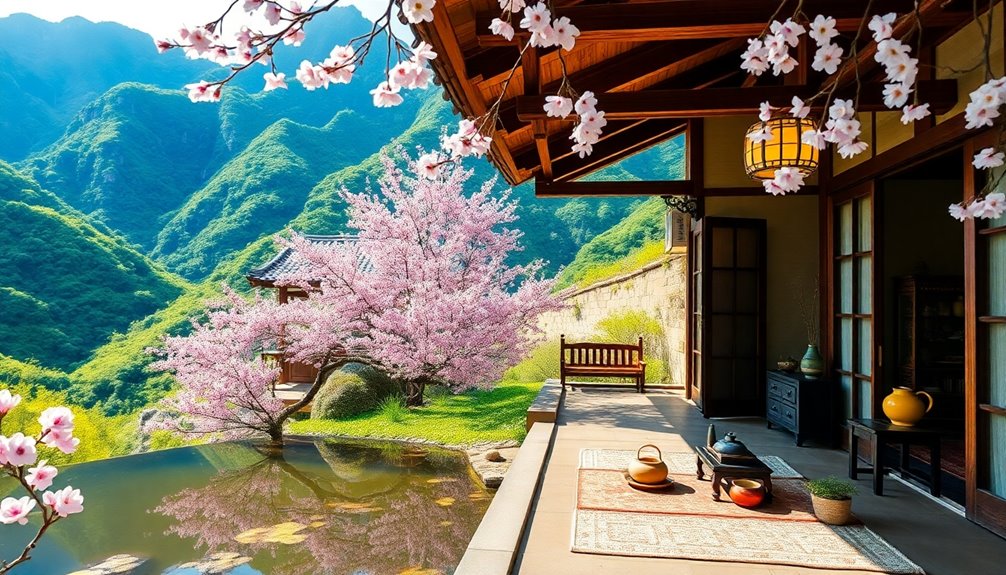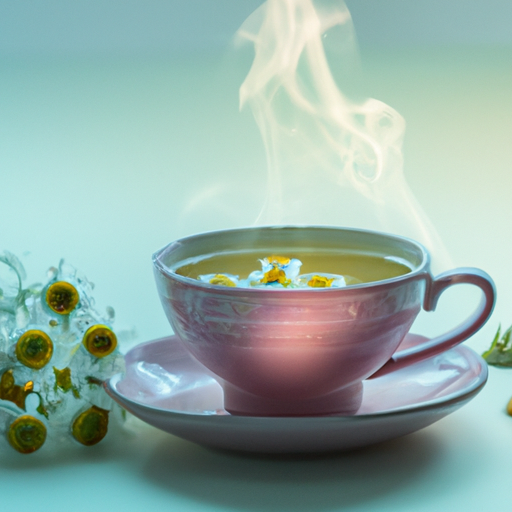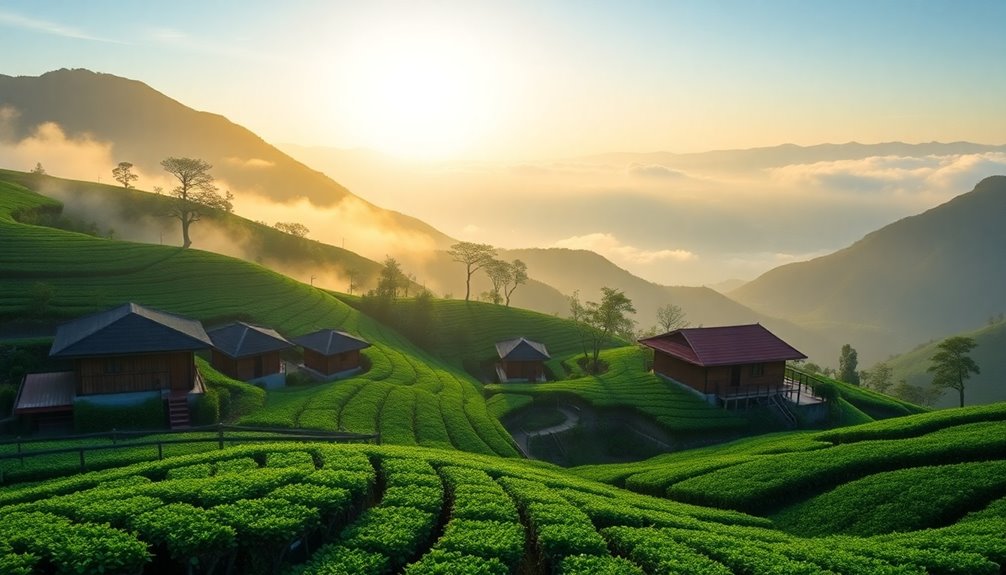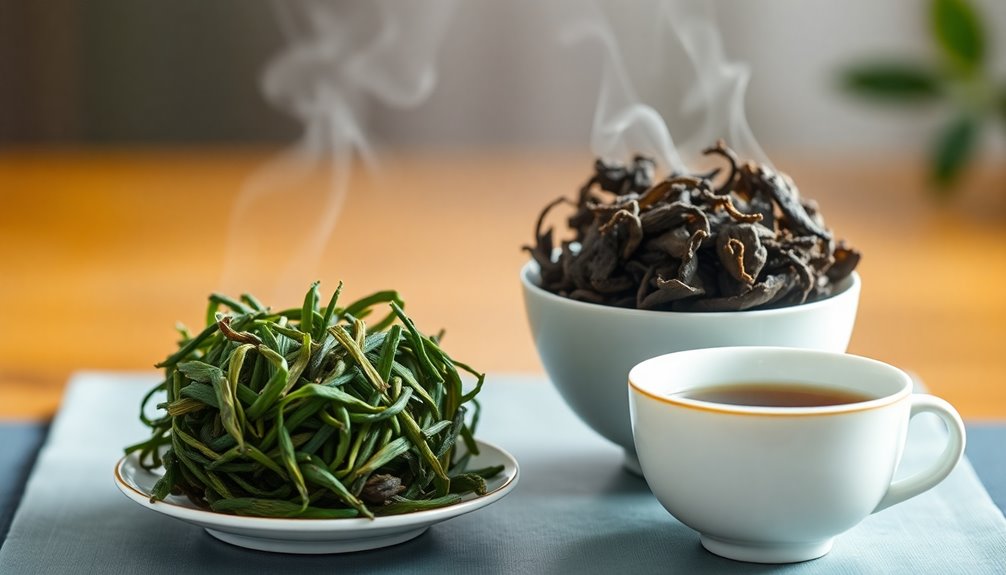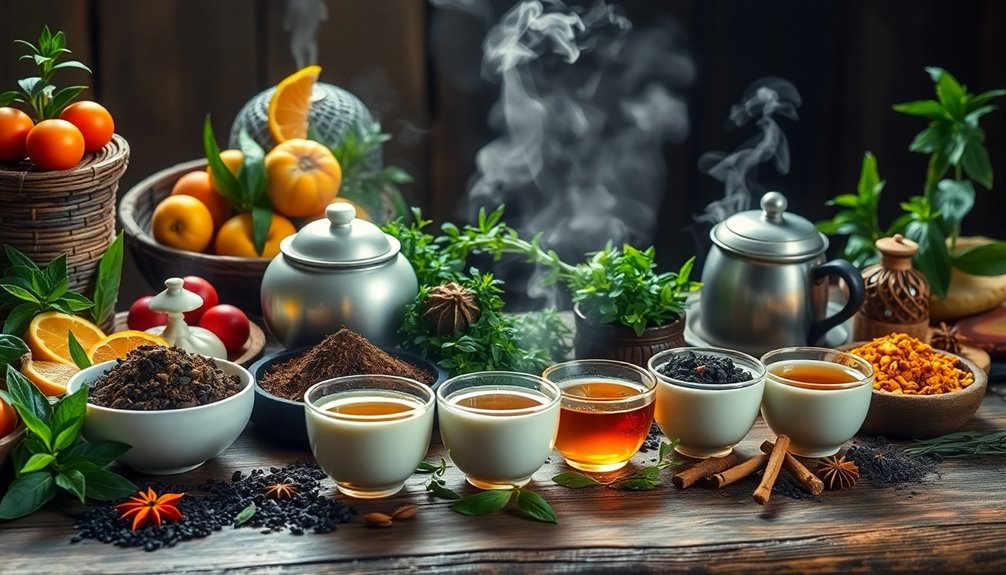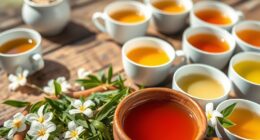When you visit traditional tea houses in Taiwan, you'll step into a joyful world of cultural delight! These cozy spots are perfect for families, offering a serene atmosphere where you can sip delicious oolong and puer tea. You can try the fun gongfu tea preparation method, making tea an exciting adventure. Don't forget to enjoy tasty local snacks too—like sweet pineapple cakes! And while you savor these flavors, you'll bond with friends and family in a peaceful setting. There are so many more flavors and experiences waiting for you, so get ready to discover even more!
Key Takeaways
- Experience the serene atmosphere of traditional tea houses, perfect for relaxation and cultural immersion in Taiwan.
- Indulge in local favorites like oolong and puer tea, prepared using the interactive gongfu tea method.
- Enjoy accompanying local snacks, such as pineapple cakes and tea-infused dumplings, to enhance your tea tasting experience.
- Engage in social interactions and meaningful conversations in tranquil gardens, making tea houses ideal for gatherings with family and friends.
- Participate in educational events to deepen your understanding of Taiwan's rich tea heritage and traditions.
Introduction
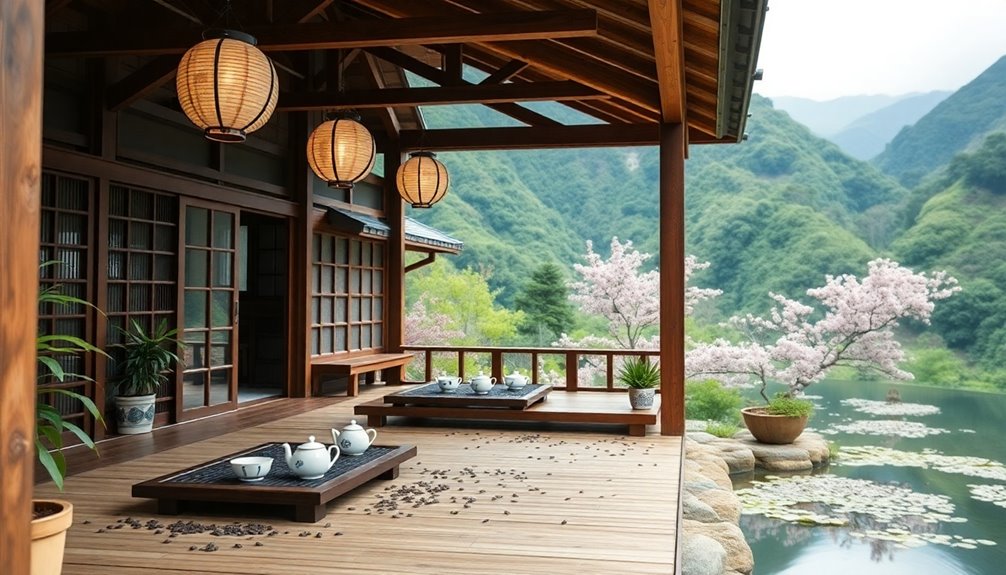
When you step into a traditional tea house in Taiwan, you're entering a serene world that beautifully blends culture and relaxation.
These charming spots, especially in Taipei, are perfect for families looking to unwind together. You'll find a delightful tea selection, focusing on local favorites like oolong tea and puer.
At places like Wistaria Tea House, you can enjoy the gongfu tea preparation method, where you learn to brew tea in a fun, hands-on way! It's an exciting experience that makes tea tasting more enjoyable.
You might spend one to three hours sipping different brews, allowing each flavor to dance on your taste buds.
Don't forget to try some local snacks along with your tea; they really enhance the tasting experience!
The peaceful atmosphere often features beautiful courtyards and traditional wooden designs, creating a perfect backdrop for your tea adventure.
During busy times, it's wise to make reservations, so you won't miss out on the fun.
Whether you're a tea lover or just curious, visiting a traditional tea house in Taiwan will surely make your trip unforgettable!
Enjoy every sip and smile!
Cultural Significance of Tea
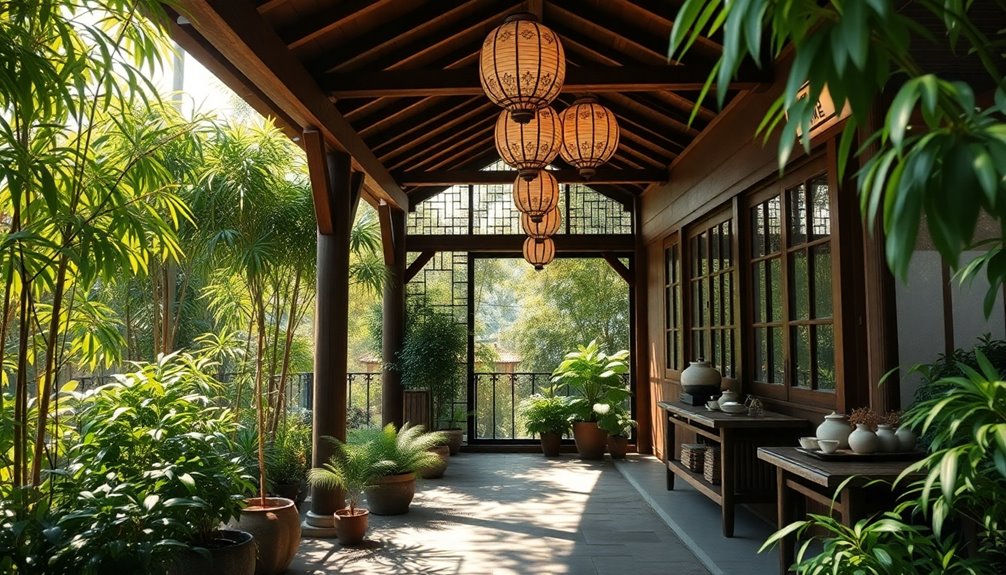
Tea holds deep cultural significance in Taiwan, weaving together history, tradition, and community. When you step into a tea house, you enter a world where the art of tea is celebrated.
These tea houses are cultural hubs, buzzing with life and creativity. You'll find traditional arts like calligraphy and music, all while enjoying the peaceful atmosphere.
One of the most exciting parts of the tea drinking experience is gongfu tea preparation. This careful brewing method makes every cup a work of art! As you sip your tea, you'll notice how it brings people together, sparking social interactions and community bonding.
It's the perfect way to relax and connect with friends and family.
Many tea houses also host educational events, allowing you to learn more about Taiwan's tea heritage. You'll discover fascinating stories and traditions that have been passed down through generations.
In this tranquil setting, you can reflect and appreciate the richness of Taiwanese culture. So, whether you're a tea lover or just curious, visiting a tea house will surely be a memorable adventure for everyone!
Tea's Role in Social Gatherings
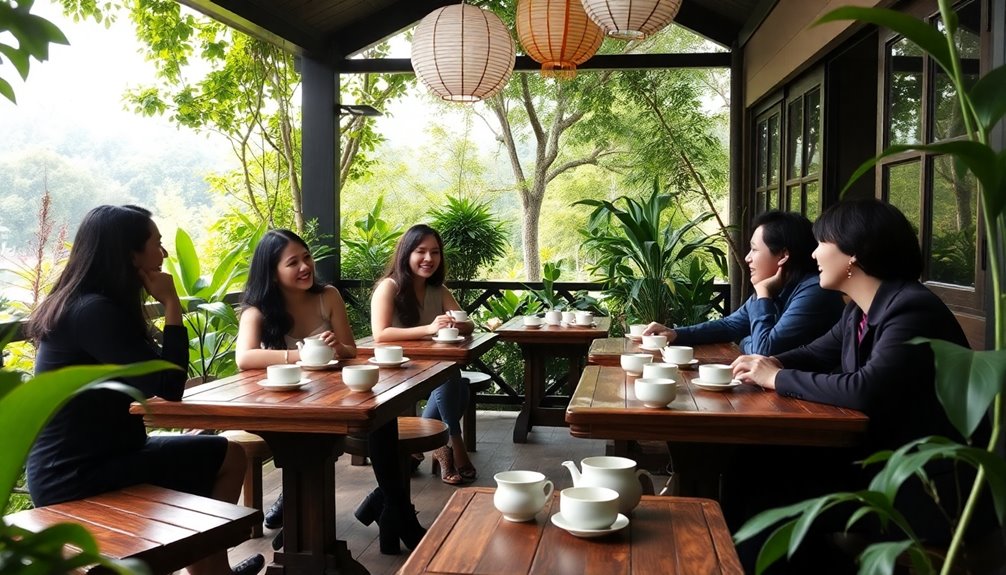
As you step into a traditional tea house in Taiwan, you'll quickly realize how integral tea is to social gatherings. These cozy spots serve as social hubs where friends and family come together to enjoy high-quality tea, especially the delightful oolong tea.
You might even find yourself participating in the gongfu tea brewing method, which makes the experience hands-on and fun!
The serene atmosphere of these tea houses, often surrounded by tranquil gardens, is perfect for relaxing and enjoying meaningful conversations. Imagine sitting with loved ones, sharing stories, and laughing together as you savor each brew.
The practice of sharing multiple cups of tea encourages you to linger longer, deepening your connections.
Tea drinking in Taiwan isn't just a refreshing break; it's a cherished part of Taiwanese culture. It's about communal bonding, appreciating the moment, and enjoying each other's company. Additionally, the calming effects of herbal teas can enhance these social interactions, promoting relaxation and connection among friends.
Tea Pairings With Local Snacks
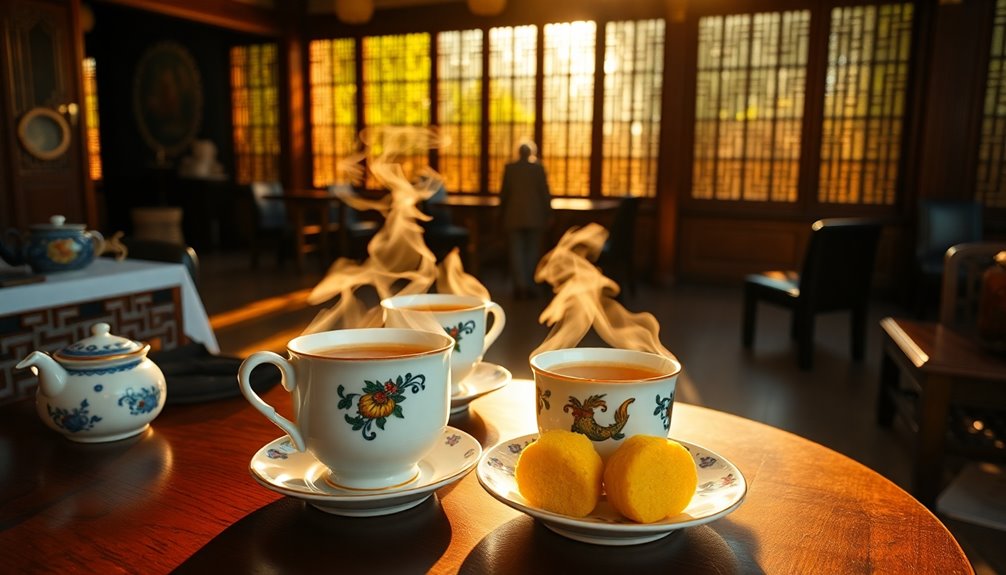
Stepping into a traditional tea house in Taiwan, you'll discover that the experience isn't just about sipping tea; it's also about savoring delicious local snacks that enhance each brew. These snacks make tea time even more special!
- High Mountain Oolong pairs perfectly with sweet treats like pineapple cakes. The floral notes of the tea contrast beautifully with the sweetness of the cake, creating a delightful balance.
- For a savory option, try tea-infused dumplings alongside aged pu-erh. The rich, earthy flavor of the tea complements the dumplings, making each bite an adventure.
- If you're in the mood for something unique, don't miss the tea-flavored ice cream! It's a refreshing twist that highlights the tea's characteristics and is sure to bring smiles to everyone's faces.
At traditional teahouses, the care taken in preparing these snacks mirrors the precise brewing of the tea. This attention to detail adds a layer of cultural appreciation to your visit.
Environmental Impact of Tea Farming
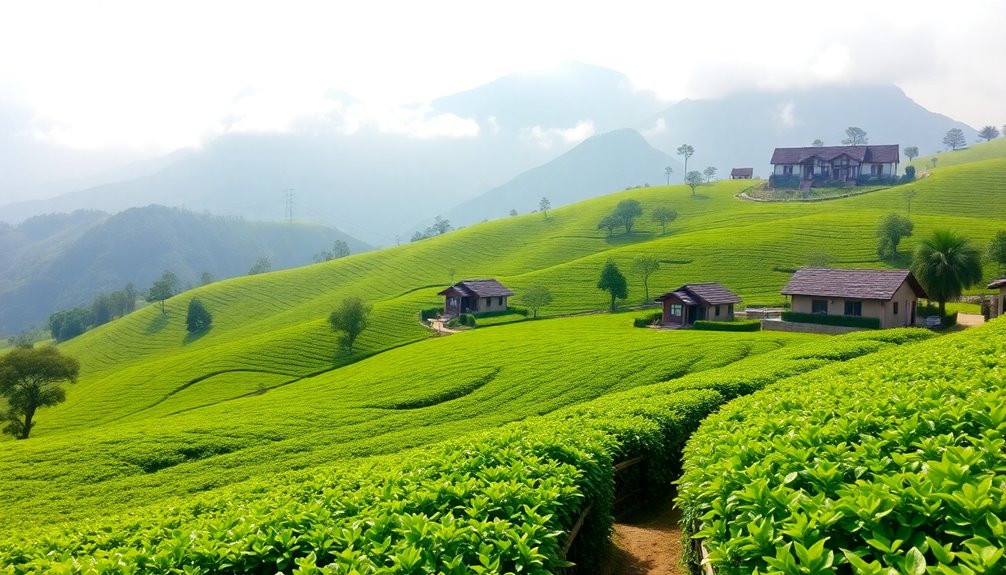
When you think about the beauty of Taiwan's tea culture, it's important to consider the environmental impact of tea farming. While sipping delicious tea, you mightn't realize that tea farming can lead to serious issues like soil erosion and water pollution.
In mountainous areas, land is often cleared for cultivation, which can harm local ecosystems and deplete precious water resources.
Fortunately, there's hope! Sustainable tea practices, like organic farming and agroforestry, are becoming more popular. These eco-friendly methods help protect the environment by reducing the use of pesticides and fertilizers.
This is great news for nearby rivers and streams, which are vital for wildlife and local communities.
The Taiwanese government encourages these practices, offering incentives for farmers to adopt techniques that improve soil health and minimize chemical use.
However, climate change is still a challenge, as changing weather patterns can affect tea quality and yield.
Practical Applications
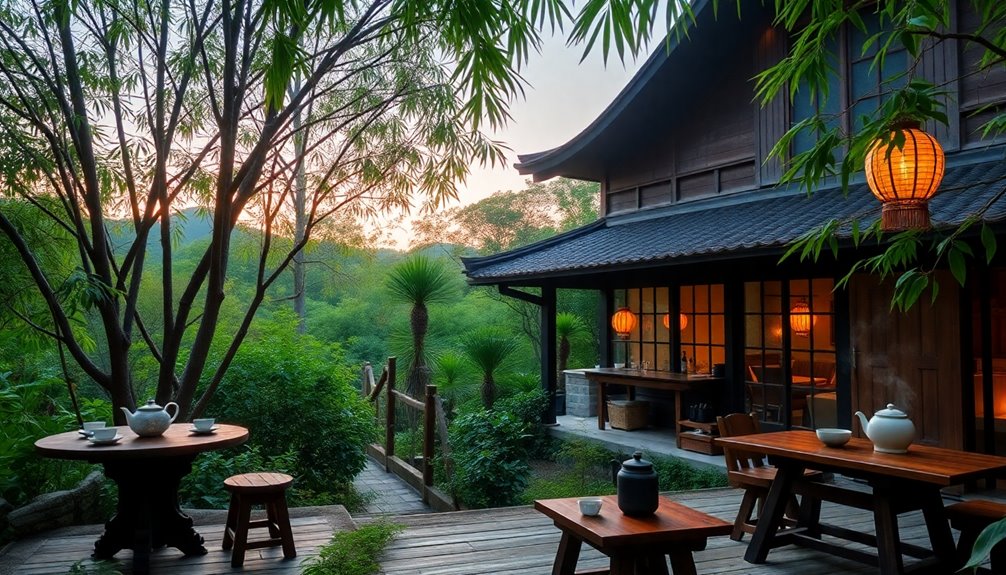
Exploring the practical applications of tea culture in Taiwan opens up a world of unique experiences and knowledge. When you visit traditional tea houses, you'll find a delightful atmosphere where you can enjoy quality Taiwanese teas.
Most places charge a small water fee, usually around TWD 180, which covers the use of brewing equipment during your tea session, lasting from 1 to 3 hours.
Here's what you can expect:
- Gongfu cha: Learn about this traditional tea preparation technique, where you can engage in the brewing process yourself.
- Tea ceremony: Experience the beauty of a tea ceremony, enhancing your appreciation of each tea's flavor.
- Reservations: Make sure to book ahead, especially on weekends, to secure your spot at popular places like Wistaria Tea House.
- Educational resources: Many tea houses offer guidance for beginners, helping you understand soaking times and water temperatures for different teas.
Each visit is a chance to explore unique tea varieties, making your time in Taiwan truly memorable.
Frequently Asked Questions
What Is Taiwan's Most Famous Tea?
Taiwan's most famous tea is oolong, especially high mountain varieties. You'll appreciate its complex flavors, ranging from floral to fruity. This tea's unique characteristics, shaped by Taiwan's climate, make it a favorite among connoisseurs.
What Is Tea Etiquette in Taiwan?
In Taiwan, you should accept tea with both hands, appreciate its aroma, and wait for the host to pour first. Always refill others' cups before yours, and tap fingers gently to thank your host.
What Is the Most Famous Taiwan Bubble Tea?
The most famous bubble tea in Taiwan is Pearl Milk Tea, also known as boba. It combines black or green tea, milk, and chewy tapioca pearls, creating a delightful mix of flavors you'll love.
What Is Traditional Taiwanese Tea?
Traditional Taiwanese tea includes oolong, puer, and high mountain varieties. You'll discover unique flavors influenced by Taiwan's climate, and experience the intricate gongfu cha brewing method, maximizing the aroma and taste through multiple steepings.
Conclusion
Visiting traditional tea houses in Taiwan is an exciting adventure for the whole family! You'll discover the rich culture of tea, share special moments with loved ones, and enjoy delicious local snacks. Plus, you'll learn about how tea farming helps our environment. So, grab your family, sip some tasty tea, and make unforgettable memories together. Each visit will fill your hearts with joy and your minds with new experiences. Happy tea exploring!

